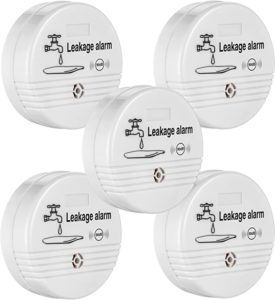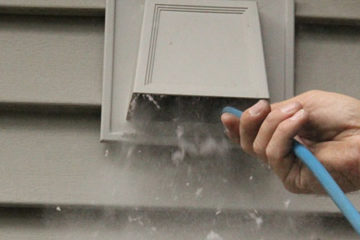Why Does My Dryer Leak Water
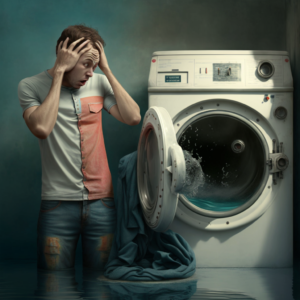 There are several potential reasons why a dryer may leak water. Some common causes include a clogged exhaust duct, a malfunctioning or clogged lint filter, or a problem with the water supply hoses connected to the dryer. Additionally, if the dryer is not level, it can cause water to leak out. It is best to consult the user manual or contact a professional to determine the specific cause of the leak and how to fix it, but before you do that, here are 5 reasons your dryer leaks water.
There are several potential reasons why a dryer may leak water. Some common causes include a clogged exhaust duct, a malfunctioning or clogged lint filter, or a problem with the water supply hoses connected to the dryer. Additionally, if the dryer is not level, it can cause water to leak out. It is best to consult the user manual or contact a professional to determine the specific cause of the leak and how to fix it, but before you do that, here are 5 reasons your dryer leaks water.
5 Reasons Why My Dryer Leaks Water
Clogged exhaust duct: Lint and other debris can build up in the exhaust duct, blocking the airflow and causing water to back up and leak out of the dryer.
Malfunctioning or clogged lint filter: If the lint filter is not cleaned regularly or is damaged, it can cause the dryer to overheat and potentially leak water.
Problem with water supply hoses: The water supply hoses connected to the dryer can become loose, cracked, or kinked, causing water to leak out.
Not level: If the dryer is not level, it can cause water to pool in one area and leak out.
Defective door seal: If the door seal of the dryer is not functioning properly, it may allow water to escape from the drum.
A Clogged Exhaust Duct Will Make Your Dryer Leak Water
A clogged exhaust duct can be a significant cause of a leaking dryer. The exhaust duct is responsible for venting hot air and moisture out of the dryer, and if it becomes blocked with lint and other debris, the airflow can be restricted. This can cause water to back up and leak out of the dryer, potentially causing damage to the surrounding area. The hot, moist air that is vented out of the dryer can also create an ideal environment for mould to grow. If mould is present in the exhaust duct, it can cause a musty smell and potential health hazards.
The blockage in the exhaust duct can occur for various reasons, such as not cleaning the lint filter regularly, not having a proper venting system, or having a long and winding venting system. Lint and other debris can build up in the exhaust duct over time, reducing the airflow and potentially causing the dryer to overheat and leak water.
To prevent this, it is essential to regularly check the exhaust duct for any blockages and to clean it as needed. This can be done by either using a long brush or a vacuum cleaner with a hose attachment to remove the lint and debris from the exhaust duct. It is also important to ensure that the venting system is installed correctly and that it is not too long or winding, making it harder for the hot air and moisture to vent out.
Additionally, it is also recommended to have your dryer vent professionally cleaned at least once a year. This will ensure that the venting system is free of blockages and that the dryer runs optimally.
In summary, a clogged exhaust duct is a common way to make your dryer leak water, and it is important to regularly check and clean the exhaust duct to prevent blockages and maintain the proper airflow. Not doing so can cause water to back up and leak out of the dryer, potentially causing damage to the surrounding area and promoting mould growth.
A Clogged Lint Filter
A malfunctioning or clogged lint filter can also cause a leaking dryer. The lint filter is designed to catch lint and other debris during the drying cycle, but if it is not cleaned regularly or is damaged, it can become clogged. This can cause the dryer to overheat, which can lead to leaks. In addition, if the lint filter is not working correctly, it can cause the dryer to use more energy, leading to higher utility bills.
A clogged lint filter can also affect the drying time of your clothes, making them take longer to dry, which can be frustrating. Sometimes, a clogged lint filter can cause the dryer to shut off before drying clothes, wasting time and energy.
To prevent this, it is important to clean the lint filter after every load of laundry and check it for any damage. If the filter is damaged, it should be replaced as soon as possible. Cleaning the lint filter is relatively simple, and it can be done by removing the filter and using a brush or a vacuum cleaner to remove the lint and debris.
Sometimes, a malfunctioning lint filter may be caused by a problem with the dryer itself, such as a faulty sensor or a malfunctioning thermostat. It is important to check the user manual or contact a professional to determine if this is the case and to have it repaired if necessary.
In conclusion, a malfunctioning or clogged lint filter can cause a dryer to overheat, leading to leaks and higher energy bills. Regularly cleaning and checking the lint filter can prevent this issue and ensure that your dryer runs optimally. If the lint filter is damaged, it should be replaced as soon as possible. If the problem persists, it’s best to consult the user manual or contact a professional to determine the specific cause of the problem.
Water Supply Hoses Burst Will Make Your Dryer Leak Water
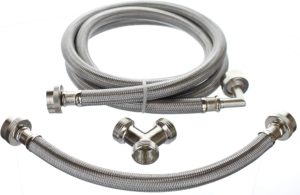 A problem with the water supply hoses connected to the dryer can also cause a leaking dryer. The water supply hoses supply water to the dryer for specific models with a steam function and moisture-sensing feature. These hoses can become loose, cracked, or kinked over time, which can cause water to leak out. A leak in the water supply hoses can also cause water damage to the surrounding area and can be a potential fire hazard if not addressed promptly.
A problem with the water supply hoses connected to the dryer can also cause a leaking dryer. The water supply hoses supply water to the dryer for specific models with a steam function and moisture-sensing feature. These hoses can become loose, cracked, or kinked over time, which can cause water to leak out. A leak in the water supply hoses can also cause water damage to the surrounding area and can be a potential fire hazard if not addressed promptly.
One of the main reasons for the water supply hoses to become damaged is regular wear and tear. Over time, the hoses can become brittle and can crack or leak due to constant exposure to water and high temperatures. Another reason can be improper installation, where the hoses are not connected properly or are kinked, which can cause the water to leak out.
To prevent this, it is essential to regularly check the hoses for any damage signs and to ensure that they are securely connected to the dryer and the water supply. If any signs of damage are found, it’s best to replace the hoses immediately. Also, it’s important to ensure that the hoses are not kinked or bent in any way, as this can cause a restriction in the water flow and lead to leaks.
In addition, it’s also important to ensure that the water supply valves are turned off before checking or replacing the hoses to avoid accidental water leakage.
In conclusion, a problem with the water supply hoses can cause a leaking dryer. Regularly checking and maintaining the hoses can prevent this issue and ensure that your dryer is running correctly. If any damage is found, it’s best to replace the hoses immediately. If the problem persists, it’s best to consult the user manual or contact a professional to determine the specific cause of the problem.
The Dryer's Not Level
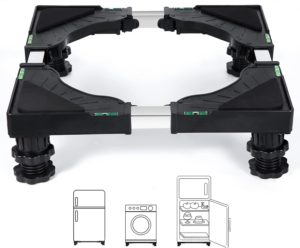 A dryer that is not level can also cause it to leak water. If the dryer is not level, it can cause water to pool in one area and leak out, potentially causing damage to the surrounding area. This can occur for various reasons, such as uneven flooring or a problem with the legs of the dryer.
A dryer that is not level can also cause it to leak water. If the dryer is not level, it can cause water to pool in one area and leak out, potentially causing damage to the surrounding area. This can occur for various reasons, such as uneven flooring or a problem with the legs of the dryer.
Level, Raise & Quiet Down Your Dryer
When the dryer is not level, the drum inside the dryer can become misaligned, which can cause the water to pool in one area. This can also affect the performance of the dryer, causing it to use more energy and take longer to dry clothes.
To prevent this, it is important to check the dryer’s level regularly and ensure it is level. This can be done by using a spirit level, which can be placed on top of the dryer to check if it is level. If the dryer is not level, it can be adjusted by adjusting the legs of the dryer.
In addition, it’s important to make sure that the flooring that the dryer is placed on is level and stable. If the flooring is uneven, it can cause the dryer to become misaligned and can lead to leaks.
In some cases, the problem can be due to malfunctioning or worn-out levelling feet, which can cause the dryer to lean to one side. In this case, it’s best to consult the user manual or contact a professional to determine if this is the case and to have it repaired if necessary.
In conclusion, a dryer that is not level can cause water to pool in one area and leak out, potentially causing damage to the surrounding area. Regularly checking and ensuring that the dryer is level and the flooring is stable can prevent this issue and ensure that your dryer is running correctly. If the problem persists, it’s best to consult the user manual or contact a professional to determine the specific cause of the problem.
A Defective Door Seal
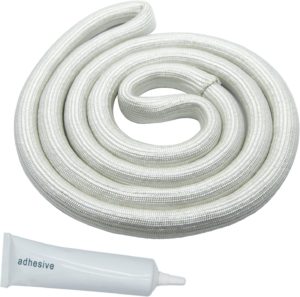 A defective door seal can also cause a dryer to leak water. The door seal, also known as the door gasket, is a rubber or vinyl strip that lines the circumference of the dryer door. Its primary function is to keep the hot air and moisture inside the drum during the drying cycle. If the door seal is not functioning correctly, it may allow water to escape from the drum, potentially causing damage to the surrounding area.
A defective door seal can also cause a dryer to leak water. The door seal, also known as the door gasket, is a rubber or vinyl strip that lines the circumference of the dryer door. Its primary function is to keep the hot air and moisture inside the drum during the drying cycle. If the door seal is not functioning correctly, it may allow water to escape from the drum, potentially causing damage to the surrounding area.
A defective door seal can occur due to a variety of reasons, such as regular wear and tear, exposure to high temperatures, or damage due to cleaning chemicals. Over time, the door seal can become brittle and can crack or tear, which can cause the water to leak out. Additionally, if the door seal is not properly maintained and cleaned, it can become dirty or mouldy, which can affect its ability to seal the door properly.
To prevent this, it is essential to regularly check the door seal for any signs of wear or damage and replace it if necessary. Also, it’s important to make sure that the door seal is adequately cleaned and maintained to ensure that it is in good condition. It is also important to make sure that the door is properly closed and latched during the drying cycle, as an open door can cause the seal to fail.
A defective door seal may sometimes be caused by a problem with the dryer itself, such as a faulty door latch or a malfunctioning door switch. It is essential to check the user manual or contact a professional to determine if this is the case and to have it repaired if necessary.
In conclusion, a defective door seal can cause a dryer to leak water, potentially causing damage to the surrounding area. Regularly checking and maintaining the door seal can prevent this issue and ensure that your dryer is running correctly. If the door seal is damaged, it should be replaced as soon as possible, and if the problem persists, it’s best to consult the user manual or contact a professional to determine the specific cause of the problem.
